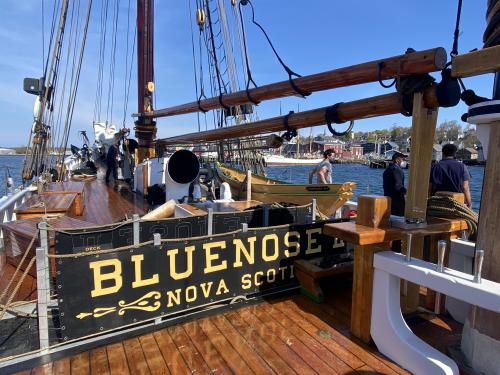Voyage to the summer berth
I cannot begin to tell you how good it feels to turn the key to start the engines and feel the low thrum of the John Deere main engines idling away and to be waiting to give the order to let go the mooring lines. The crew have put in six weeks of long days painting and varnishing and it’s time to get off the wharf, even for few minutes.
It is amazing to see the change in the young crew as the gangway is brought aboard and the order is given to stand by their lines. As the lines are peeled off and the ship leans against the corner of the pier to pivot towards the channel, eyes are wide and little is said. The helmsman, acutely aware of their responsibility, is listening hard for the orders, “10 degrees to starboard, midships, steady.” All of a sudden, the last line is slipped and we are free. With a surge of power to move the ship ahead and allow some water to flow past the rudder we are moving towards the channel and along the waterfront.
As we slip out from behind the museum, we can see people walking towards the wharf to have a better look. Ships are a magnet to people on the shore. They hold promise of lands unknown, of adventures on the high seas with fish, mammals, and weather unknown to the common person. Well, not really, but there remains a mystery behind a ship moving along a waterfront.

Here in Lunenburg, as in many places in coastal Nova Scotia, time is marked by the coming and going of vessels in port. At times, a calendar is best used to mark the time. Maude Adams, a modern scallop dragger flying the flag of Adams and Knickle marks her time away in 10-day increments. Picton Castle measures her absence in years. Here on Bluenose II, sometimes we are gone for two hours for a harbour tour, sometimes three weeks or even months depending on where our mission takes us.
Even on a two-hour tour, with the engines off and sails up, the idea of travelling in a new world is present. Treated with a visit by a pod of porpoises or a curious seal, life changes altogether. Occasionally we will see some pelagic sea birds lured by the calm and abundant food supply of Lunenburg Bay swimming idly. I wonder if the anomaly of a large ship under sail has any memory for the creatures we meet.
Enough waxing poetic, we still have a tremendous amount of technical work to do. There are inspections due for our fire gear, climbing gear, life rafts, radios and then an overarching inspection by our regulatory body. They will come and see us rescue a person overboard, fight fires, abandon ship and anchor the vessel. I’m not sure how many other vessels go through what we do but I’m very happy to have an experienced set of eyes check us out and point us towards areas of improvement.


